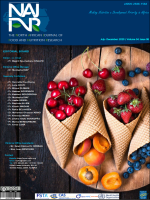Main Article Content
Phenolic compounds and antioxidant activity of different parts of three mandarin varieties extracts: A comparative study
Abstract
Background:Mandarin by-products, such as peels and seeds, are considered as one of the naturel sources of phenolic compounds. Aim:The objective of the present study was to compare the phenolic compounds contents and antioxidant activity of different parts (pulps, seeds, juices, and peels) of three mandarins varieties extracts.Materialand methods: Total phenolic, flavonoid, and proanthocyanidin contents of the extracts were assessed while, the antioxidant activity was evaluated using three tests including ferric reducing power, free radical scavenging activity, and phosphomolybdate. Results:The Mediterranean Mandarin peels present a high total phenolics and flavonoids contents with values of 2445.62 mg GAE/100g FW and 609.78 mg QE/100g FW, respectively. Likewise, the clementine juice showed the highest proanthocyanins contents with a value of 46.67 mg CE/100g FW. Seeds and pulps of the three varieties present the lowest phenolic compound contents. Mediterranean Mandarin juice showed a strong ferric reducing power and phosphomolybdate with values of 1270.91 and 190.19 mg AAE/100g FW, respectively, however, the peels revealed a strong free radical scavenging activity with value of 259.89 mg AAE/100 g FW. Statistical analysis showed a positive correlation between the antioxidant activity and the phenolic compounds contents of the three studied mandarins varieties extracts. Conclusion: Among the analyzed cultivars, the Mediterranean mandarin variety may be considered as the most promising source of polyphenols and antioxidants, compared to the clementine and Satsuma varieties. Moreover, this study also highlights important properties of the fruit parts generally considered wastes.







